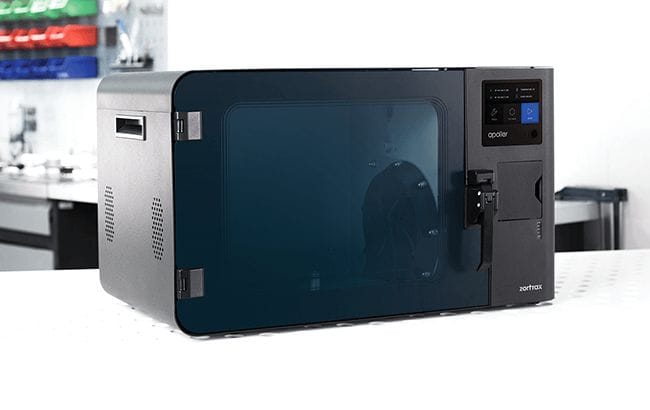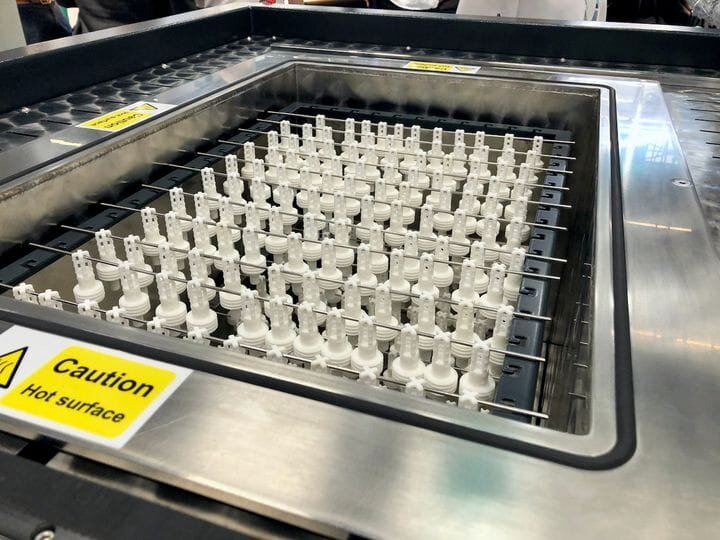![The new Apoller Smart Vapor Smoothing Device [Source: Zortrax]](https://fabbaloo.com/wp-content/uploads/2020/05/image-asset_img_5eb0a32072da1.jpg)
Zortrax announced the Apoller Smart Vapor Smoothing Device.
This machine is an accessory for 3D printers, and provides an ability to smooth the typically layered surface of 3D prints using chemical action.
There are several chemicals known to soften common 3D print materials. The most familiar of which is acetone, which can, if supplied in sufficient volume, dissolve objects made from ABS thermoplastic. The trick is to apply these chemicals in a controlled fashion equally to all sides of the object to smooth it by gently softening the exterior surface.
Although some may “paint” a solvent onto a print to soften surfaces, the most typically done approach is by vaporizing the solvent so that the chemical can be carefully exposed to all surfaces of the object, even those hidden from normal views.
The problem is that the solvents are typically hazardous in some way. Acetone, for example, is quite flammable and considerable care must be taken to avoid incidents, particularly when it is vaporized. Because of this acetone vaporization systems are typically closed environments.
Acetone works very well on ABS materials, but hardly at all on PLA, the most commonly used 3D print material. Exposing a PLA print to acetone won’t get you too far. However, instead you can use something called “MEK”, or methyl ethyl ketone, and is sometimes called “Butanone”.
Is MEK safe? By no means so – it is flammable, and according to Wikipedia, a “constituent of tobacco smoke.” It is an irritant and has shown effect of exposure on animals. It is also rumored to cause neuropsychological effects, and is listed on the United Nations Convention Against Illicit Traffic in Narcotic Drugs and Psychotropic Substances.
Thus these two solvents are not often used by 3D printer operators to smooth materials because of these effects.
![A 3D print smoothed by the Apoller [Source: Zortrax]](https://fabbaloo.com/wp-content/uploads/2020/05/image-asset_img_5eb0a320a05e7.jpg)
However, some companies have endeavored to produce machines that can enable their use more safely and reliably. A new entrant to that market is Zortrax, who have announced the Apoller, a device specifically designed to provide controlled solvent vapor exposure for 3D prints.
Zortrax explains how the system works:
“Zortrax Apoller is a desktop SVS system working with acetone or MEK to smooth FDM 3D printed models. With an intuitive touch interface and proprietary algorithms managing the smoothing process, the Zortrax Apoller is the next step in additive manufacturing.
Vapor-smoothed models get the look of injection-molded parts with a glossy or matte finish depending on the filament used. With a dual condensation process, a 300ml bottle of solvent can be used for smoothing multiple prints instead of just one. This efficiency means that the combined weekly output of four typical FDM 3D printers can be automatically smoothed within one day without loss of quality.”
In fact, Zortrax seems to have taken special steps to ensure the safety of the device and its operator:
“Safety is always a concern and the Zortrax Apoller makes it a top priority for users. Zortrax Apoller offers industrial-class reliability through redundancies carefully engineered into the system. The smoothing chamber stays closed until the solvents are safely contained in their tanks, ensuring the Apoller meets the European ATEX Workplace Directives for improving worker protection from explosive atmospheres. Power outage? Not a problem, as the chamber will stay sealed. When the power comes back on, the Zortrax Apoller will automatically decontaminate the chamber. This makes vapor smoothing a viable post-processing technique in the prototyping process while maintaining utmost safety in the workplace.”
The device also includes a vacuum seal to ensure that the precious and potentially dangerous solvents do not leak out onto the operator or the surrounding environment.
What’s quite interesting about the device is that it can recycle the solvents after use. The two solvents designed to be used in the Apoller, acetone and MEK, can both be recaptured, thus lowering operating costs.
Like any proper smart device, the Apoller is equipped with a WiFi interface for remote control, and has a fancy touchscreen for local operation.
There is a limitation: the enclosed smoothing chamber has dimensions of 300 x 250 x 250 mm, so you cannot smooth parts larger than that size. However, you can include several parts in one smoothing job, as there are no three dimensional restrictions. I imagine one could use a metal rack to hold a series of objects to be smoothed.
With the use of acetone and MEK, the Apoller can smooth objects made from PLA, HIPS, ASA or ABS.
While the machine is obviously targeted at Zortrax users, it seems to me that it could also be used by anyone else with 3D prints in those materials, even if they do not have a Zortrax machine. However, it is likely that Zortrax’s recipes for smoothing will be based on their own specific material chemistries, so using the Apoller on third party materials might require some experimentation.
There’s no word on pricing yet, but we hope to see the device in person at formnext. But we won’t be breathing any MEK!
Zortrax will be exhibiting in Hall 3.1, booth A81 at formnext.
Via Zortrax











